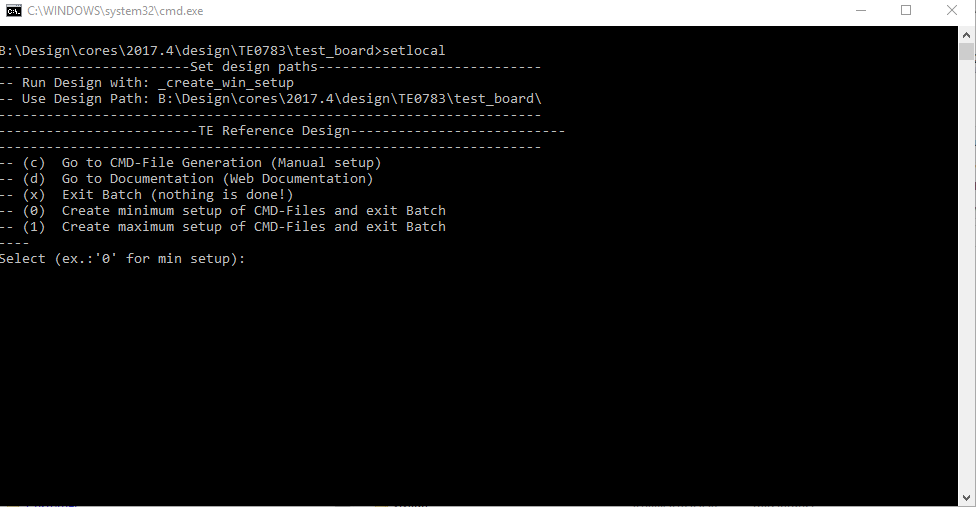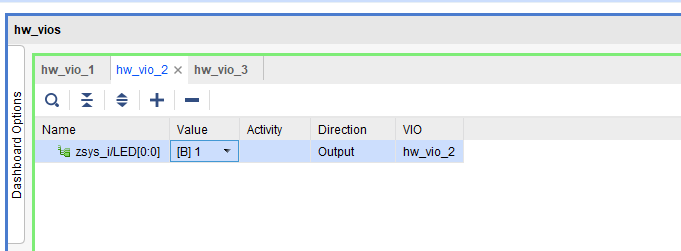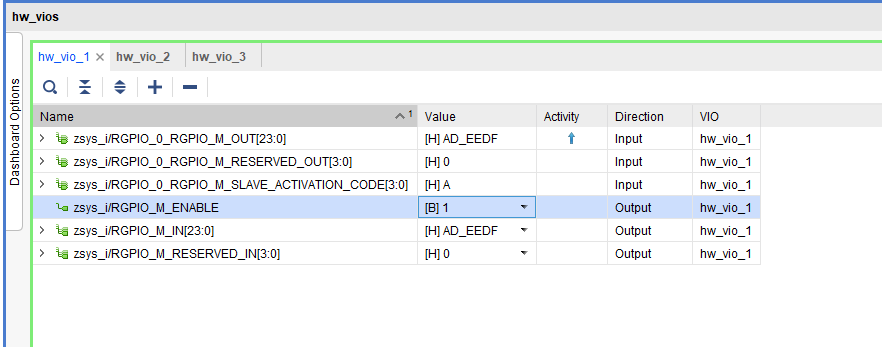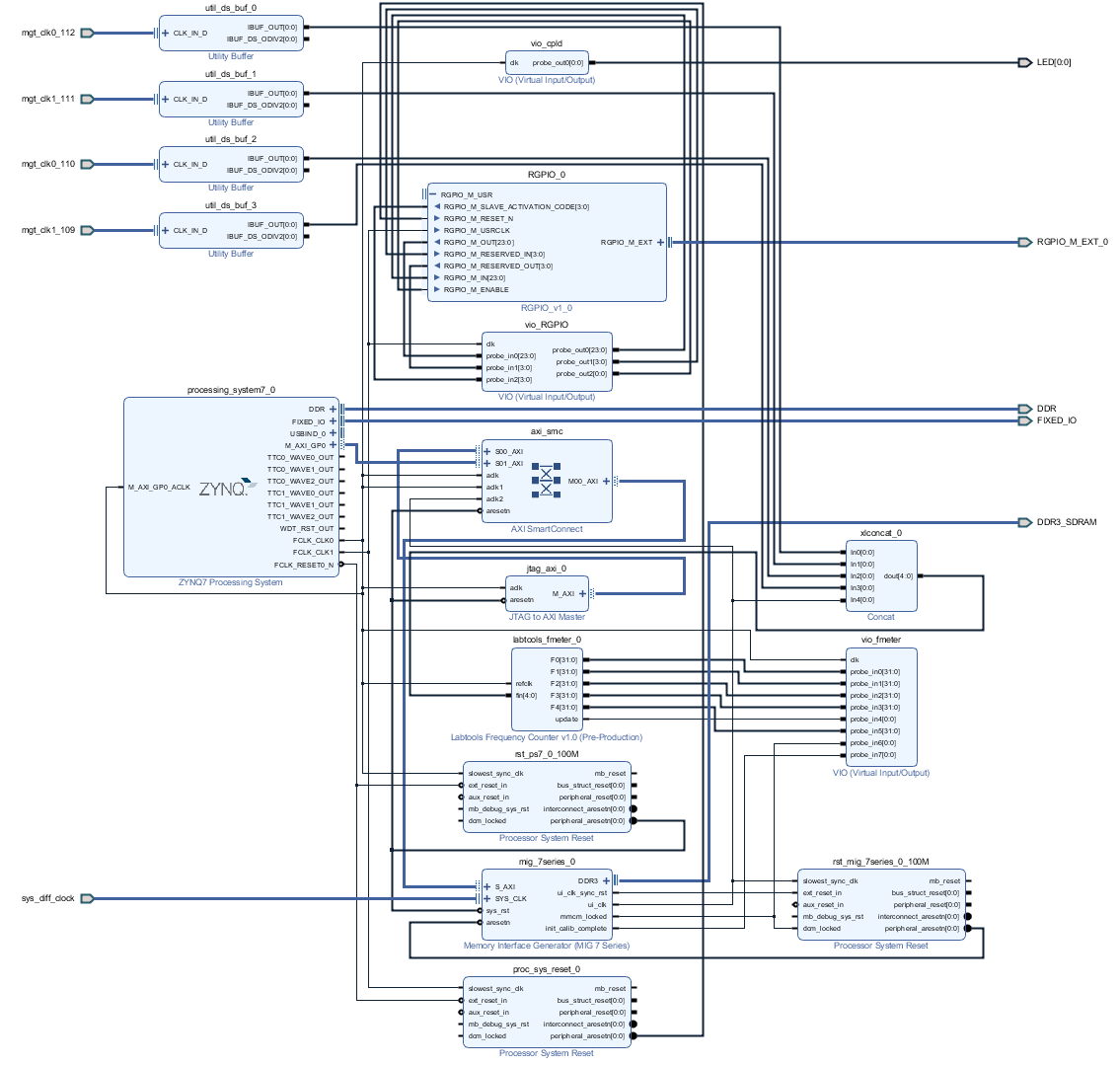<!-- Template Revision 1.3 Basic Notes - export PDF to download, if vivado revision is changed! - Template is for different design and SDSoC and examples, remove unused or wrong description! --> |
Online version of this manual and other related documents can be found at https://wiki.trenz-electronic.de/display/PD/Trenz+Electronic+Documentation |
Table of contents |
<!-- General Design description --> |
Zynq PS Design with Linux Example. Add simple frequency counter to measure SI5338 Reference CLK and RGPIO IP to get access to CPLD IOs with Vivado HW-Manager.
<!-- Add Basic Key Features of the design (should be tested) --> |
|
<!-- - Add changes from design - Export PDF to download, if vivado revision is changed! --> |
| Date | Vivado | Project Built | Authors | Description |
|---|---|---|---|---|
| 2018-06-01 | 2017.4 | TE0783-test_board_noprebuilt-vivado_2017.4-build_10_20180611114036.zip TE0783-test_board-vivado_2017.4-build_10_20180611114017.zip | John Hartfiel | initial release |
<!-- - add known Design issues and general Notes for the current revision --> |
| Issues | Description | Workaround | To be fixed version |
|---|---|---|---|
| No known issues | --- | --- | --- |
<!-- Add needed external Software --> |
| Software | Version | Note |
|---|---|---|
| Vivado | 2017.4 | needed |
| SDK | 2017.4 | needed |
| PetaLinux | 2017.4 | needed |
| SI5338 Clock Builder | --- | optional |
<!-- Hardware Support --> |
Basic description of TE Board Part Files is available on TE Board Part Files.
Complete List is available on <design name>/board_files/*_board_files.csv
Design supports following modules:
| Module Model | Board Part Short Name | PCB Revision Support | DDR | QSPI Flash | Others | Notes |
|---|---|---|---|---|---|---|
| TE0783-01-45-2I | 45_2i | REV01 | 1GB PS, 2GB PL | 32MB |
Design supports following carriers:
| Carrier Model | Notes |
|---|---|
| TEBT0782 | SD not available |
Additional HW Requirements:
| Additional Hardware | Notes |
|---|---|
| USB Cable for JTAG/UART | Check Carrier Board and Programmer for correct type |
| XMOD Programmer | Carrier Board dependent, only if carrier has no own FTDI |
<!-- Remove unused content --> |
For general structure and of the reference design, see Project Delivery
| Type | Location | Notes |
|---|---|---|
| Vivado | <design name>/block_design <design name>/constraints <design name>/ip_lib | Vivado Project will be generated by TE Scripts |
| SDK/HSI | <design name>/sw_lib | Additional Software Template for SDK/HSI and apps_list.csv with settings for HSI |
| PetaLinux | <design name>/os/petalinux | PetaLinux template with current configuration |
| Type | Location | Notes |
|---|---|---|
| SI5338 | <design name>/misc/Si5338 | SI5345 Project with current PLL Configuration |
<!-- <table width="100%"> <tr> <th>File </th> <th>File-Extension</th> <th>Description </th> </tr> <tr> <td>BIF-File </td> <td>*.bif </td> <td>File with description to generate Bin-File </td> </tr> <tr> <td>BIN-File </td> <td>*.bin </td> <td>Flash Configuration File with Boot-Image (Zynq-FPGAs) </td> </tr> <tr> <td>BIT-File </td> <td>*.bit </td> <td>FPGA Configuration File </td> </tr> <tr> <td>DebugProbes-File </td> <td>*.ltx </td> <td>Definition File for Vivado/Vivado Labtools Debugging Interface </td> </tr> <tr> <td>Debian SD-Image </td> <td>*.img </td> <td>Debian Image for SD-Card </td> </tr> <tr> <td>Diverse Reports </td> <td> --- </td> <td>Report files in different formats </td> </tr> <tr> <td>Hardware-Platform-Specification-Files</td> <td>*.hdf </td> <td>Exported Vivado Hardware Specification for SDK/HSI </td> </tr> <tr> <td>LabTools Project-File </td> <td>*.lpr </td> <td>Vivado Labtools Project File </td> </tr> <tr> <td>MCS-File </td> <td>*.mcs </td> <td>Flash Configuration File with Boot-Image (MicroBlaze or FPGA part only) </td> </tr> <tr> <td>MMI-File </td> <td>*.mmi </td> <td>File with BRAM-Location to generate MCS or BIT-File with *.elf content (MicroBlaze only) </td> </tr> <tr> <td>OS-Image </td> <td>*.ub </td> <td>Image with Linux Kernel (On Petalinux optional with Devicetree and RAM-Disk) </td> </tr> <tr> <td>Software-Application-File </td> <td>*.elf </td> <td>Software Application for Zynq or MicroBlaze Processor Systems </td> </tr> <tr> <td>SREC-File </td> <td>*.srec </td> <td>Converted Software Application for MicroBlaze Processor Systems </td> </tr> </table> --> |
File | File-Extension | Description |
|---|---|---|
| BIF-File | *.bif | File with description to generate Bin-File |
| BIN-File | *.bin | Flash Configuration File with Boot-Image (Zynq-FPGAs) |
| BIT-File | *.bit | FPGA (PL Part) Configuration File |
| DebugProbes-File | *.ltx | Definition File for Vivado/Vivado Labtools Debugging Interface |
Debian SD-Image | *.img | Debian Image for SD-Card |
| Diverse Reports | --- | Report files in different formats |
| Hardware-Platform-Specification-Files | *.hdf | Exported Vivado Hardware Specification for SDK/HSI and PetaLinux |
| LabTools Project-File | *.lpr | Vivado Labtools Project File |
| OS-Image | *.ub | Image with Linux Kernel (On Petalinux optional with Devicetree and RAM-Disk) |
| Software-Application-File | *.elf | Software Application for Zynq or MicroBlaze Processor Systems |
Reference Design is only usable with the specified Vivado/SDK/PetaLinux/SDx version. Do never use different Versions of Xilinx Software for the same Project.
<!-- Add correct path:https://shop.trenz-electronic.de/en/Download/?path=Trenz_Electronic/TE0803/Reference_Design/2017.1/Starterkit --> |
Reference Design is available on:
<!-- Basic Design Steps Add/ Remove project specific --> |
Reference Design is available with and without prebuilt files. It's recommended to use TE prebuilt files for first lunch. |
Trenz Electronic provides a tcl based built environment based on Xilinx Design Flow.
See also:
The Trenz Electronic FPGA Reference Designs are TCL-script based project. Command files for execution will be generated with "_create_win_setup.cmd" on Windows OS and "_create_linux_setup.sh" on Linux OS.
TE Scripts are only needed to generate the vivado project, all other additional steps are optional and can also executed by Xilinx Vivado/SDK GUI. For currently Scripts limitations on Win and Linux OS see: Project Delivery Currently limitations of functionality

<!-- Description of Block Design, Constrains... BD Pictures from Export... --> |
Check Module and Carrier TRMs for proper HW configuration before you try any design. |
Xilinx documentation for programming and debugging: Vivado/SDK/SDSoC-Xilinx Software Programming and Debugging
Optional for Boot.bin on QSPI Flash and image.ub on SD.
Not used on this Example.
Not used on this Example.
SI5338 MGT Reference CLKs:
PL MIG Status Status signal:

Custom LED
Red LED D1 can be controlled via VIO.

RGPIO
RGPIO Pins can be controlled via VIO

<!-- Description of Block Design, Constrains... BD Pictures from Export... --> |

| Typ | Note |
|---|---|
| DDR3 | |
| QSPI | MIO |
| ETH0 | MIO |
| USB0 | MIO |
| SD0 | MIO |
| SD1 | MIO |
| I2C0 | MIO |
| SWDT0..1 | |
| TTC0..3 |
set_property BITSTREAM.GENERAL.COMPRESS TRUE [current_design] set_property CONFIG_VOLTAGE 3.3 [current_design] set_property CFGBVS VCCO [current_design] |
#set_property PACKAGE_PIN AA8 [get_ports {SI_MGT_CLK0_110_clk_p[0]}]
#set_property PACKAGE_PIN N8 [get_ports {SI_MGT_CLK0_112_clk_p[0]}]
#set_property PACKAGE_PIN AF10 [get_ports {SI_MGT_CLK1_109_clk_p[0]}]
#set_property PACKAGE_PIN W8 [get_ports {SI_MGT_CLK1_111_clk_p[0]}]
#set_property IOSTANDARD DIFF_SSTL15 [get_ports {MIG_SYS_CLK_clk_p[0]}]
#set_property PACKAGE_PIN H9 [get_ports {MIG_SYS_CLK_clk_p[0]}]
# -------------
#LED
set_property PACKAGE_PIN AE20 [get_ports {LED[0]}]
set_property IOSTANDARD LVCMOS33 [get_ports {LED[0]}]
# -------------
#RGPIO
set_property PACKAGE_PIN AB19 [get_ports RGPIO_M_EXT_0_clk]
set_property PACKAGE_PIN AB20 [get_ports RGPIO_M_EXT_0_rx]
set_property PACKAGE_PIN AD20 [get_ports RGPIO_M_EXT_0_tx]
set_property IOSTANDARD LVCMOS33 [get_ports RGPIO_M_EXT_0_clk]
set_property IOSTANDARD LVCMOS33 [get_ports RGPIO_M_EXT_0_rx]
set_property IOSTANDARD LVCMOS33 [get_ports RGPIO_M_EXT_0_tx] |
set_false_path -from [get_clocks clk_fpga_0] -to [get_clocks {zsys_i/util_ds_buf_0/U0/IBUF_OUT[0]}]
set_false_path -from [get_clocks clk_fpga_0] -to [get_clocks {zsys_i/util_ds_buf_1/U0/IBUF_OUT[0]}]
set_false_path -from [get_clocks clk_fpga_0] -to [get_clocks {zsys_i/util_ds_buf_2/U0/IBUF_OUT[0]}]
set_false_path -from [get_clocks clk_fpga_0] -to [get_clocks {zsys_i/util_ds_buf_3/U0/IBUF_OUT[0]}]
set_false_path -from [get_clocks {zsys_i/util_ds_buf_0/U0/IBUF_OUT[0]}] -to [get_clocks clk_fpga_0]
set_false_path -from [get_clocks {zsys_i/util_ds_buf_1/U0/IBUF_OUT[0]}] -to [get_clocks clk_fpga_0]
set_false_path -from [get_clocks {zsys_i/util_ds_buf_2/U0/IBUF_OUT[0]}] -to [get_clocks clk_fpga_0]
set_false_path -from [get_clocks {zsys_i/util_ds_buf_3/U0/IBUF_OUT[0]}] -to [get_clocks clk_fpga_0] |
<!-- optional chapter separate sections for different apps --> |
For SDK project creation, follow instructions from:
Source location: \sw_lib\sw_apps
TE modified 207.4 FSBL
Changes:
TE modified 2017.4 FSBL
Changes:
U-Boot.elf is generated with PetaLinux. SDK/HSI is used to generate Boot.bin.
<!-- optional chapter Add "No changes." or "Activate: and add List" --> |
For PetaLinux installation and project creation, follow instructions from:
Deactivate:
No changes.
/include/ "system-conf.dtsi"
/ {
};
/* default */
/* QSPI */
&qspi {
#address-cells = <1>;
#size-cells = <0>;
status = "okay";
flash0: flash@0 {
compatible = "jedec,spi-nor";
reg = <0x0>;
#address-cells = <1>;
#size-cells = <1>;
//spi-max-frequency = <50000000>;
};
};
/* ETH PHY ETH0 */
&gem0{
status = "okay";
phy-handle = <&phy0>;
xlnx,has-mdio = <0x1>;
mdio {
#address-cells = <1>;
#size-cells = <0>;
phy0: phy@1 {
compatible = "marvell,88e1510";
device_type = "ethernet-phy";
reg = <1>;
marvell,reg-init = <0x3 0x10 0x0000 0x0501 0x3 0x11 0x0000 0x4415>;
};
};
};
/* USB 0 PHY */
/{
usb_phy0: usb_phy@0 {
compatible = "ulpi-phy";
#phy-cells = <0>;
reg = <0xe0002000 0x1000>;
view-port = <0x0170>;
drv-vbus;
};
};
&usb0 {
usb-phy = <&usb_phy0>;
} ;
/* RTC over I2C0 */
&i2c0 {
rtc@6F { // Real Time Clock
compatible = "isl12022";
reg = <0x6F>;
};
};
|
Activate:
Activate:
<!-- Add Description for other Software, for example SI CLK Builder ... --> |
No additional software is needed.
Download ClockBuilder Desktop for SI5338
To get content of older revision got to "Change History" of this page and select older document revision number.
<!-- Generate new entry: 1:add new row below first 2:Copy Page Information Macro(date+user) Preview, Page Information Macro Preview 3.Update Metadate =Page Information Macro Preview+1 --> |
| Date | Document Revision | Authors | Description |
|---|---|---|---|
| |||
| 2018-05-30 | v.1 |
| |
| All |